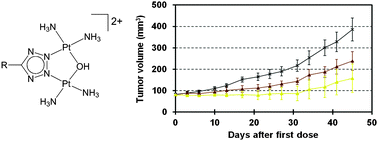We synthesised four tetrazolato-bridged dinuclear Pt(II) complexes, [{cis-Pt(NH3)2}2(μ-OH)(μ-5-R-tetrazolato-N2,N3)]n+, where R is CH3 (1), C6H5 (2), CH2COOC2H5 (3), or CH2COO− (4) and n = 2 (1–3) or 1 (4). Their structures were characterised by 1H, 13C, and 195Pt NMR spectroscopy, mass spectrometry, and elemental analysis, and the crystal structure of 1 was determined by X-ray crystallography. The cytotoxicities of the complexes to human non-small-cell lung cancer (NSCLC) cell lines sensitive and resistant to cisplatin were assayed. Complex 1 was more cytotoxic than cisplatin in both PC-9 and PC-14 NSCLC cell lines, and cross-resistance to 1 in the cisplatin-resistant cells was largely circumvented. Complex 3 was moderately cytotoxic, whereas 2 and 4 were only marginally cytotoxic. We also determined the growth inhibitory activities of 1 and 3, as well as prototype azolato-bridged complexes [{cis-Pt(NH3)2}2(μ-OH)(μ-pyrazolato)]2+ (AMPZ), [{cis-Pt(NH3)2}2(μ-OH)(μ-1,2,3-triazolato-N1,N2)]2+ (AMTA), [{cis-Pt(NH3)2}2(μ-OH)(μ-tetrazolato-N1,N2)]2+ (5-H-X), and [{cis-Pt(NH3)2}2(μ-OH)(μ-tetrazolato-N2,N3)]2+ (5-H-Y), against a panel of 39 human cancer cell lines (JFCR39). The average 50% growth inhibition concentrations of the complexes against the JFCR39 cell lines ranged from 0.933 to 23.4 μM. The cytotoxicity fingerprints of the complexes based on the JFCR39 cytotoxicity data were similar to one another but completely different from the fingerprints of clinical platinum-based anticancer drugs. Complex 3 exhibited marked antitumor efficiency when tested in vivo on xenografts of PANC-1 pancreatic cancer in nude mice. The high potency of 3 confirmed that the tetrazolato-bridged structure exhibits high in vivo antitumor efficacy.


 Please wait while we load your content...
Please wait while we load your content...